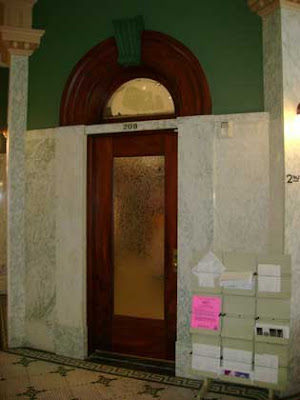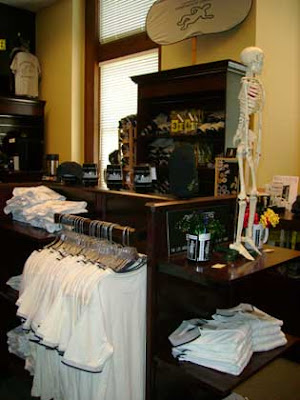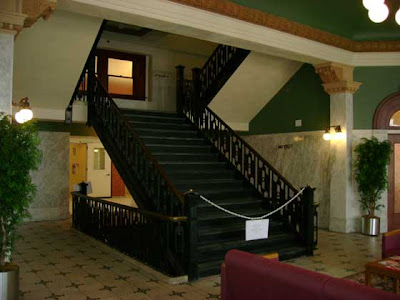March 31, 1930 – The Motion Pictures Production Code is instituted, imposing strict guidelines on the treatment of sex, crime, religion and violence in film for the next thirty eight years.
The Motion Picture Production Code was the set of industry censorship guidelines which governed the production of the vast majority of United States motion pictures released by major studios from 1930 to 1968. It was originally popularly known as the Hays Code, after its creator, Will H. Hays.
The Motion Pictures Producers and Distributors Association (MPPDA), which later became the Motion Picture Association of America (MPAA), adopted the code in 1930, began effectively enforcing it in 1934, and abandoned it in 1968, in favor of the subsequent MPAA film rating system. The Production Code spelled out what was acceptable and what was unacceptable content for motion pictures produced for a public audience in the United States.
The office enforcing it was originally popularly called the Breen Office, named after its first administrator, Joseph I. Breen.
Provisions of the Code
The Production Code enumerated three "General Principles" as follows:
1.No picture shall be produced that will lower the moral standards of those who see it. Hence the sympathy of the audience should never be thrown to the side of crime, wrongdoing, evil or sin.
2.Correct standards of life, subject only to the requirements of drama and entertainment, shall be presented.
3.Law, natural or human, shall not be ridiculed, nor shall sympathy be created for its violation.
Specific restrictions were spelled out as "Particular Applications" of these principles:
Nakedness and suggestive dances were prohibited.
The ridicule of religion was forbidden, and ministers of religion were not to be represented as comic characters or villains.
The depiction of illegal drug use was forbidden, as well as the use of liquor, "when not required by the plot or for proper characterization".
Methods of crime (e.g. safe-cracking, arson, smuggling) were not to be explicitly presented.
References to alleged sex perversion (such as homosexuality) and venereal disease were forbidden, as were depictions of childbirth.
The language section banned various words and phrases that were considered to be offensive.
Murder scenes had to be filmed in a way that would discourage imitations in real life, and brutal killings could not be shown in detail. "Revenge in modern times" was not to be justified.
The sanctity of marriage and the home had to be upheld. "Pictures shall not imply that low forms of sex relationship are the accepted or common thing". Adultery and illicit sex, although recognized as sometimes necessary to the plot, could not be explicit or justified and were not supposed to be presented as an attractive option.
Portrayals of miscegenation (inter-racial marriage and procreation) were forbidden.
"Scenes of Passion" were not to be introduced when not essential to the plot. "Excessive and lustful kissing" was to be avoided, along with any other treatment that might "stimulate the lower and baser element".
The flag of the United States was to be treated respectfully, and the people and history of other nations were to be presented "fairly".
The treatment of "Vulgarity", defined as "low, disgusting, unpleasant, though not necessarily evil, subjects" must be "subject to the dictates of good taste". Capital punishment, "third-degree methods", cruelty to children, animals, prostitution and surgical operations were to be handled with similar sensitivity.
History
Before the Production Code
City and state censorship ordinances are as old as the movies themselves. However, after the United States Supreme Court ruled in 1915 (Mutual Film Corporation v. Industrial Commission of Ohio) that motion pictures were merely a business and not an art form, and thus not covered by the First Amendment, such ordinances banning the public exhibition of "immoral" films proliferated. The movie studios feared that federal regulations were not far off.
In the early 1920s, three major scandals rocked Hollywood: the manslaughter trials of comedy star Roscoe "Fatty" Arbuckle, who was charged with being responsible for the death of actress Virginia Rappe at a wild party in San Francisco during Labor Day weekend of 1921; the murder of director William Desmond Taylor in February 1922 and the revelations regarding his bisexuality; and the drug-related death of popular actor Wallace Reid in January 1923.
Other allegedly drug-related deaths of stars Olive Thomas, Barbara La Marr, Jeanne Eagels, and Alma Rubens resulted in persistent calls for censorship and "cleaning up" of Hollywood through the 1920s. These stories were sensationalized in the press and grabbed headlines across the country. They appeared to confirm a widespread perception that many Americans had of Hollywood — that it was "Sin City".
Public outcry over perceived immorality in Hollywood and the movies, as well as the growing number of city and state censorship boards, led to the creation in 1922 of the Motion Pictures Producers and Distributors Association (which became the Motion Picture Association of America in 1945), an industry trade and lobby organization. The association was headed by Will H. Hays, a well-connected Republican lawyer who had previously been United States Postmaster General and the 1920 campaign manager for President Warren G. Harding. Hays immediately banned Fatty Arbuckle from the movies and instituted a morality clause to apply to anyone working in films. He also derailed attempts to institute federal censorship over the movies.
In 1927 Hays compiled a list of subjects, culled from his experience with the various U.S. censorship boards, which he felt Hollywood studios would be wise to avoid. He called this list "the formula" but it was popularly known as the "don'ts and be carefuls" list around town. In 1930 Hays created the Studio Relations Committee (SRC) to implement his censorship code, but the SRC lacked any real enforcement capability.
1930 to 1934
The advent of talking pictures in 1927 led to a perceived need for further enforcement. Martin Quigley, the publisher of a Chicago-based motion picture trade newspaper, began lobbying for a more extensive code that not only listed material that was inappropriate for the movies, but also contained a moral system that the movies could help to promote — specifically a system based on Catholic theology.[1] He recruited Father Daniel Lord, a Jesuit priest and instructor at Saint Louis University, to write such a code and on March 31, 1930 the board of directors of the Motion Picture Producers and Distributors Association adopted it formally. This original version became popularly known as the Hays Code, but both it and its subsequent revisions are now generally referred to as the Production Code.
However, Depression economics and changing social mores resulted in the studios producing racier fare that the Code, lacking an aggressive enforcement body, was unable to redress. This era is known as Pre-Code Hollywood.
Enforcement
In response to such movies as Warner Brothers' Baby Face (starring Barbara Stanwyck) and Paramount Pictures' I'm No Angel (starring and written by Mae West), Quigley and Joseph I. Breen, Will Hays's Los Angeles-based assistant, enlisted the Catholic Church to exert pressure on the Hollywood studios. They helped spearhead the creation of the Catholic Legion of Decency as well as boycotts and blacklists of the movies throughout the country.
An amendment to the Code, adopted on June 13, 1934, established the Production Code Administration (PCA), and required all films released on or after July 1 1934 to obtain a certificate of approval before being released. The first film to receive an MPPDA seal of approval was The World Moves On. For more than thirty years following, virtually all motion pictures produced in the United States adhered to the code.[2] The Production Code was not created or enforced by federal, state, or city government. In fact, the Hollywood studios adopted the code in large part in the hopes of avoiding government censorship, preferring self-regulation to government regulation.
The enforcement of the Production Code led to the dissolution of many local censorship boards. Meanwhile, the U.S. Customs Department prohibited the importation of the Czech film Ecstasy (1933), starring an actress soon to be known as Hedy Lamarr, an action which was upheld on appeal.
In 1934, Joseph I. Breen (1888–1965) was appointed head of the new Production Code Administration (PCA). Under Breen's leadership of the PCA, which lasted until his retirement in 1954, enforcement of the Production Code became rigid and notorious. Breen's power to change scripts and scenes angered many writers, directors, and Hollywood moguls. The PCA had two offices, one in Hollywood, and the other in New York City. Films approved by the New York PCA office were issued certificate numbers that began with a zero.
Breen influenced the production of Casablanca, objecting to any explicit reference to Rick and Ilsa having slept together in Paris, and to mentioning that Captain Renault extorted sexual favors from his supplicants. However, both remained strongly implied in the finished version.[3] Adherence to the code also ruled out in advance any possibility of the film ending with Rick and Ilsa consummating their adulterous love, effectively making inevitable the ending with Rick's noble renunciation, one of Casablanca's most famous scenes.[4]
The first major instance of censorship under the Production Code involved the 1934 film Tarzan and His Mate, in which brief nude scenes involving a body double for actress Maureen O'Sullivan were edited out of the master negative of the film. Another famous case of enforcement involved the 1943 western The Outlaw, produced by Howard Hughes. The Outlaw was denied a certificate of approval and kept out of theaters for years because the film's advertising focused particular attention on Jane Russell's breasts. Hughes eventually persuaded Breen that the breasts did not violate the code and the film could be shown.
Some films produced outside the mainstream studio system during this time did flout the conventions of the code, such as Child Bride (1938), which featured a nude scene involving 12-year-old actress Shirley Mills. Even cartoon sex symbol Betty Boop had to change from being a flapper, and began to wear an old-fashioned housewife skirt.
The Code began to weaken in the late 1940s, when the formerly taboo subjects of rape and miscegenation were allowed in Johnny Belinda (1948) and Pinky (1949), respectively. The Moon Is Blue caused controversy due to director Otto Preminger's insistence on keeping "virgin", a word not used in Hollywood films since the early 1930s, in the script. The film eventually was nominated for several Academy Awards.
Kings Row
The character of Cassandra (Betty Field) posed a challenge for Warner Brothers because of incest and promiscuity in the novel Kings Row.A film adaptation of Henry Bellamann's controversial 1940 novel, Kings Row, presented problems for producers at Warner Brothers because of the Production Code. The novel contained significant sexual content, including references to incest, as well as euthanasia and the sadism of one of its principal characters, the town physician. It was initially believed that the Code made a movie adaptation of the novel impossible.[5] Joseph I. Breen, director of the Production Code Authority, which administered the Production Code, wrote to the producers that "To attempt to translate such a story to the screen, even though it would be re-written to conform to the provisions of the Production Code is, in our judgment, a very questionable undertaking from the standpoint of the good and welfare of this industry".[5] Breen objected to "illicit sexual relationships" between characters in the movie "without sufficient compensating moral values", and also objected to "the general suggestion of loose sex...which carries throughout the entire script".[6] Breen said that any screenplay, no matter how well done, would likely bring condemnation of the film industry "from decent people everywhere" because of "the fact that it stems from so thoroughly questionable a novel. He said that the script was being referred to his superior, Will Hays, "for a decision as to the acceptability of any production based upon the novel, Kings Row".[7]
Screenwriter Casey Robinson, producer Hal B. Wallis and associate producer David Lewis[7] met with Breen to resolve these issues, with Wallis saying that the film would "illustrate how a doctor could relieve the internal destruction of a stricken community". Breen said that his office would approve the film if all references to incest, nymphomania, euthanasia and homosexuality, which had been suggested in the novel, be removed. All references to nude bathing were to be eliminated and "the suggestion of a sex affair between Randy and Drake will be eliminated entirely". It was agreed that Dr. Tower would know about the affair between Cassandra and Parris, and "that this had something to do with his killing of the girl".[7] After several drafts were rejected, Robinson was able to satisfy Breen. The film was released in February 1942.[5]
Political Censorship
When Warner Bros wanted to make a film about concentration camps in Nazi Germany, the production office forbade it, with threats to take the matter to the federal government if they proceeded with making it. This policy prevented a number of anti-Nazi films being produced. In 1938, the FBI unearthed and prosecuted a Nazi spy ring, subsequently allowing Warner Bros to produce Confessions of a Nazi Spy.[8]
The 1950s and early 1960s
Hollywood worked within the confines of the Production Code until the late 1950s, by which time the "Golden Age of Hollywood" had ended, and the movies were faced with very serious competitive threats. The first threat came from a new technology, television, which did not require Americans to leave their house to watch moving pictures. Hollywood needed to offer the public something it could not get on television, which itself was under an even more restrictive censorship code.
In addition to the threat of television, there was also increasing competition from foreign films, like Vittorio de Sica's Bicycle Thieves (1948), the Swedish film Hon dansade en sommar (English title: One Summer of Happiness) (1951), and Ingmar Bergman's Sommar med Monika (Summer with Monika) (1953). For De Sica's film, there was a censorship controversy when the MPAA demanded a scene where the lead characters talk to the prostitutes of a brothel be removed, regardless of the fact that there is no sexual or provocative activity. The Swedish films were the first to include nude love scenes, and made an international sensation.
Vertical integration in the movie industry had been found to violate anti-trust laws, and studios had been forced to give up ownership of theatres by the U.S. Supreme Court in United States v. Paramount Pictures, Inc. (1948). The studios had no way to keep foreign films out, and foreign films were not bound by the Production Code. The anti-trust rulings also helped pave the way for independent art houses that would show films created by people such as Andy Warhol and others working outside the studio system.
Finally, a boycott from the Legion of Decency no longer guaranteed a commercial failure, and thus the Code prohibitions began to vanish when Hollywood producers ignored the Code and were still able to earn profits.
The MPAA revised the code in 1951, not to make it more flexible but to make it more rigid. The 1951 revisions spelled out more words and subjects that were prohibited, and no doubt increased the opposition of movie-makers to the code.
In 1952, in the case of Joseph Burstyn, Inc. v. Wilson, the U.S. Supreme Court unanimously overruled its 1915 decision and held that motion pictures were entitled to First Amendment protection, so that the New York State Board of Regents could not ban The Miracle, a short film that was one half of L'Amore (1948), an anthology film directed by Roberto Rossellini. Film distributor Joseph Burstyn released the film in the U.S. in 1950, and the case became known as the "Miracle Decision" due to its connection to Rossellini's film. That in turn reduced the threat of government regulation that justified the Production Code, and the PCA's powers over the Hollywood industry were greatly reduced.[9]
At the forefront of contesting the code was director Otto Preminger, whose films violated the code repeatedly in the 1950s. His 1953 film The Moon is Blue, about a young woman who tries to play two suitors off against each other by claiming that she plans to keep her virginity until marriage, was the first film to use the words "virgin", "seduce" and "mistress", and it was released without a certificate of approval. He later made The Man with the Golden Arm (1955) which portrayed the prohibited subject of drug abuse, and Anatomy of a Murder (1959) which dealt with rape. Preminger's films were direct assaults on the authority of the Production Code and, since they were successful, hastened its abandonment.
In 1954 Joseph Breen retired and Geoffrey Shurlock was appointed as his successor. Variety noted "a decided tendency towards a broader, more casual approach" in the enforcement of the code.
By the late 1950s increasingly explicit films began to appear, such as Anatomy of a Murder (1959), Suddenly Last Summer (1959), Some Like It Hot (1959), and The Dark at the Top of the Stairs (1961). The MPAA reluctantly granted the seal of approval for these films, but not until certain cuts were made. Billy Wilder's Some Like It Hot (1959) was released without a certificate of approval due to its themes and became box office hits, and as a result further weakened the authority of the code.
In the early 1960s films began to deal with adult subjects and sexual matters that had not been seen in Hollywood films since the early 1930s. The MPAA reluctantly granted the seal of approval for these films, again not until certain cuts were made. The Code was finally abandoned in 1967. In that year, Warner Brothers wanted to release the new film Who's Afraid of Virginia Woolf?. When Jack Valenti became President of the MPAA in 1966, he was faced with censoring the film's explicit language. Valenti negotiated a compromise: the word "screw" was removed but other language remained, including the phrase "hump the hostess". The film received Production Code approval despite this prohibited language.
The Pawnbroker and the end of the Code
In the early 1960s, British films such as Victim (1961), A Taste of Honey (1961) and The Leather Boys (1963) offered a daring social commentary about gender roles and homosexuality, that violated the Hollywood Production Code, yet the films were still released in America. The American gay rights, civil rights, and youth movements prompted a reevaluation of the depiction of themes of race, class, gender, and sexuality that had been restricted by the Code.
In 1964, the Holocaust film The Pawnbroker, directed by Sidney Lumet and starring Rod Steiger, was initially rejected because of two scenes in which the actresses Linda Geiser and Thelma Oliver fully expose their breasts, and because of a sex scene between Oliver and Jaime Sánchez which it described as "unacceptably sex suggestive and lustful". Despite the rejection, the film's producers arranged for Allied Artists to release the film without the Production Code seal, with the New York censors licensing The Pawnbroker without the cuts demanded by Code administrators. The producers also appealed the rejection to the Motion Picture Association of America.[10]
On a 6-3 vote, the MPAA granted the film an "exception" conditional on "reduction in the length of the scenes which the Production Code Administration found unapprovable". The exception to the code was granted as a "special and unique case", and was described by The New York Times at the time as "an unprecedented move that will not, however, set a precedent".[11] The requested reductions of nudity were minimal; the outcome was viewed in the media as a victory for the film's producers.[10]
The Pawnbroker was the first film featuring bare breasts to receive Production Code approval. In his 2008 study of films during that era, Pictures at a Revolution, author Mark Harris wrote that the MPAA's action was "the first of a series of injuries to the Production Code that would prove fatal within three years".[11]
The British-produced, but American financed film Blowup (1966) presented a different problem. After the film was denied Production Code approval, MGM released it anyway, the first instance of an MPAA member company distributing a film that didn't have an approval certificate. There was little the MPAA could do about it.
Enforcement had become impossible, and the Production Code was abandoned entirely. The MPAA began working on a rating system, under which film restrictions would lessen. The MPAA film rating system went into effect on November 1, 1968 with four ratings: G, M, R, and X. In 1969, the Swedish film I Am Curious (Yellow) directed by Vilgot Sjöman, was initially banned in the U.S. for its frank depiction of sexuality; however this was overturned by the Supreme Court.
The M rating was changed to GP in 1970 and to the current PG in 1972. In 1984, in response to public complaints regarding the severity of horror elements in PG-rated titles such as Gremlins and Indiana Jones and the Temple of Doom, the PG-13 rating was created as a middle tier between PG and R. In 1990, the X rating was replaced by NC-17, in part because the X rating was not trademarked by the MPAA whereas pornographic bookstores and theatres were using their own trademark X and XXX symbols to market their products.
See also
Comics Code Authority, which functions similarly for the comics industry.
Pre-Code Hollywood
Censorship in the United States
ESRB|Entertainment Software Ratings Board, which offers ratings for video games in a similar grouping to Motion Pictures.
PMRC, a similar group which sought to control musical content with the Parental Advisory sticker.
The Celluloid Closet
This Film Is Not Yet Rated
Notes
1.^ Leff, Leonard J. Dame in the kimono Hollywood, censorship, and the production code from the 1920s to the 1960s. New York: Grove Weidenfeld, 1990. Print. pp.9
2.^ Doherty, Thomas "The Code Before 'Da Vinci'" Washington Post (May 20, 2006)
3.^ Censored Films and Television at University of Virginia online
4.^ Harmetz, pp.162–166 and Behlmer, pp.207–208 and 212–213
5.^ Wood, Brett. "Kings Row". TCM website. Turner Classic Movies.
6.^ Friedrich, Otto (1997). City of nets: a portrait of Hollywood in the 1940's. University of California Press (reprint). pp. 86–89. IS
7.^ Behlmer, Rudy (1985). Inside Warner Bros. (1935-1951). New York, NY, U.S.A.: Viking. pp. 135–141.
8.^ The Brothers Warner (2008) documentary.
9.^ Sperling, Millner, and Warner (1998), Hollywood Be Thy Name, Prima Publishing, p. 325.
10.^ Leff, Leonard J. (1996). "Hollywood and the Holocaust: Remembering The Pawnbroker" (PDF). American Jewish History 84 (4): 353–376.
11.^ Harris, Mark (2008). Pictures at a Revolution: Five Movies and the Birth of the New Hollywood. Penguin Group. pp. 173–176.
Further reading
Miller, Frank, Censored Hollywood; Atlanta: Turner Publishing, 1994
Lewis, Jon, Hollywood v. Hard Core: How the Struggle Over Censorship Saved the Modern Film Industry; New York University Press, 2000
LaSalle, Mick, Complicated Women: Sex and Power in Pre-Code Hollywood; New York: St. Martin's Press, 2000
Wednesday, March 31, 2010
Monday, March 15, 2010
Hillside Strangler Kenneth Bianchi's Tamarind Ave. Hollywood Apartment
 In May of 1977, she told him she was expecting his child...He wanted to marry Kelli, but she was not sure that she wanted to accept the offer. While Kenny was very kind to her, he had some serious faults. He was very jealous, immature and he lied. Kenny lost his job over some pot that was found in his desk, but he was able to get another similar job in downtown L.A. He and Kelli moved to an apartment at 1950 Tamarind Avenue in Hollywood.
In May of 1977, she told him she was expecting his child...He wanted to marry Kelli, but she was not sure that she wanted to accept the offer. While Kenny was very kind to her, he had some serious faults. He was very jealous, immature and he lied. Kenny lost his job over some pot that was found in his desk, but he was able to get another similar job in downtown L.A. He and Kelli moved to an apartment at 1950 Tamarind Avenue in Hollywood.-- Crime Library at truTV.com
 In mid-December, police were called to a vacant lot on a steep hillside on Alvarado Street where they found the body of Kimberly Diane Martin, a tall, blonde call-girl who had been working for the Climax "modeling agency." This time the police department had what seemed like two reasonably good leads. Kimberly Martin's last client had beckoned her to Apartment 114 at 1950 Tamarind, which turned out to be a vacant apartment. The murderer had called from a pay phone in the lobby of the Hollywood Public Library on Ivar Street.
In mid-December, police were called to a vacant lot on a steep hillside on Alvarado Street where they found the body of Kimberly Diane Martin, a tall, blonde call-girl who had been working for the Climax "modeling agency." This time the police department had what seemed like two reasonably good leads. Kimberly Martin's last client had beckoned her to Apartment 114 at 1950 Tamarind, which turned out to be a vacant apartment. The murderer had called from a pay phone in the lobby of the Hollywood Public Library on Ivar Street.-- Crime Library at truTV.com

"THE HILLSIDE STRANGLER" - Select Clips
Chuck Parello's "The Hillside Strangler" stars C. Thomas Howell as Ken Bianchi and Nicholas Turturro as Angelo Buono
Sunday, March 14, 2010
Hillside Strangler Angelo Buono's Auto Upholstery Shop
In the spring of 1977, Angelo Buono, Jr. and his younger cousin Kenneth Bianchi began their murder spree, killing women and dumping their bodies on the hillsides northeast of downtown Los Angeles in the Glendale-Highland Park-Eagle Rock-Mt. Washington area. The media dubbed the murderers, “The Hillside Stranglers.”

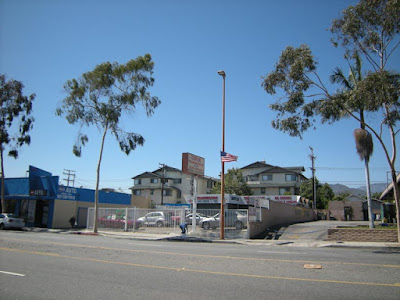 In 1986, while in prison, Buono married Christine Kizuka, a mother of three and a supervisor at the California State Department of Employee Development.
In 1986, while in prison, Buono married Christine Kizuka, a mother of three and a supervisor at the California State Department of Employee Development.
Buono was found dead on September 21, 2002 at Calipatria State Prison. Buono, who was alone in his cell at the time of his death, died of a heart attack.
In 2007, Buono's grandson, Christopher Buono, committed suicide shortly after shooting his grandmother, Mary Castillo, in the head. Castillo was at one time married to Angelo Buono, and had five children with him, including Chris' father.
In the 1989 film The Case of the Hillside Stranglers, Buono was portrayed by actor Dennis Farina. In the 2004 film The Hillside Strangler, Buono was portrayed by actor Nicholas Turturro.
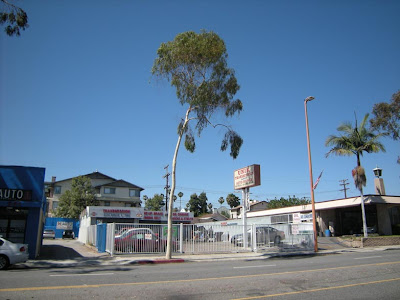

By 1975, Angelo had built himself a reasonable reputation as an auto upholsterer. He bought a place at 703 East Colorado Street for his residence and his upholstery shop. He had no use for employees, so the new place gave him the privacy to do any horrible thing he wanted.
-- Crime Library on truTV.com
An important moment in these interviews came when Salerno asked Kenny what type of material was used to blindfold Judy Miller. Kenny thought it was foam that Angelo used in his auto upholstery business. The little piece of fluff that Salerno had found on the dead girl's eyelids could be just the kind of corroborating evidence they needed to nail Angelo.
-- Crime Library on truTV.com
 In 1986, while in prison, Buono married Christine Kizuka, a mother of three and a supervisor at the California State Department of Employee Development.
In 1986, while in prison, Buono married Christine Kizuka, a mother of three and a supervisor at the California State Department of Employee Development. Buono was found dead on September 21, 2002 at Calipatria State Prison. Buono, who was alone in his cell at the time of his death, died of a heart attack.
In 2007, Buono's grandson, Christopher Buono, committed suicide shortly after shooting his grandmother, Mary Castillo, in the head. Castillo was at one time married to Angelo Buono, and had five children with him, including Chris' father.
In the 1989 film The Case of the Hillside Stranglers, Buono was portrayed by actor Dennis Farina. In the 2004 film The Hillside Strangler, Buono was portrayed by actor Nicholas Turturro.

Saturday, March 13, 2010
Hillside Strangler Kenneth Bianchi's Glendale Bachelor Pad
Kenny (Kenneth Bianchi) left Rochester in late 1975 when he was 26 and went to live in Los Angeles. He started out living with his older cousin, Angelo Buono. At first he was seduced by the uninhibited California culture where sex and drugs were freely available. Eventually, he got tired of that and started to settle down.
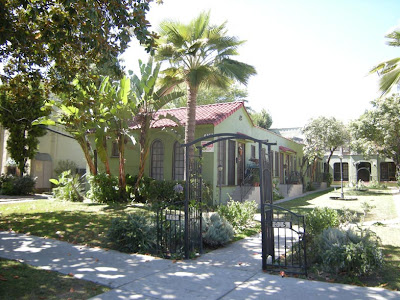 His first love was police work, but there were no openings available in the Los Angles Police Department and the Glendale Police Department turned him down. Eventually, he got a job working for a title company and used his first paycheck to get an apartment at 809 East Garfield Avenue in Glendale and a 1972 Cadillac sedan, overextending himself financially in the process. Kenny was never strong on financial responsibility.
His first love was police work, but there were no openings available in the Los Angles Police Department and the Glendale Police Department turned him down. Eventually, he got a job working for a title company and used his first paycheck to get an apartment at 809 East Garfield Avenue in Glendale and a 1972 Cadillac sedan, overextending himself financially in the process. Kenny was never strong on financial responsibility.
There were a number of young women who lived in his apartment building. One of them, Kristina Weckler, tried to ignore his advances, but others were more receptive. He moved in with Kelli Boyd, a woman he had met at work. In May of 1977, she told him she was expecting his child.
The next day, the first girl that (LAPD Homicide Detective Sergeant) Bob Grogan investigated was identified as Kristina Weckler, a quiet 20-year-old honors student at the Pasadena Art Center of Design. As he searched her apartment at 809 East Garfield Avenue in Glendale, Grogan was overcome by sadness followed by rage. Her effects and her diary showed her to be a loving and serious young woman who should have had a bright future ahead of her.
-- Crime Library on truTV.com
 He moved to Los Angeles in 1977, and started spending time with his older cousin Angelo Buono, who was impressed with Bianchi's fancy clothes, jewelry, and stories of getting any women he wanted and "putting them in their place." Before long, they worked together as pimps, and, by late 1977, had escalated to murder. They had raped and murdered 10 women by the time they were arrested in early 1979.
He moved to Los Angeles in 1977, and started spending time with his older cousin Angelo Buono, who was impressed with Bianchi's fancy clothes, jewelry, and stories of getting any women he wanted and "putting them in their place." Before long, they worked together as pimps, and, by late 1977, had escalated to murder. They had raped and murdered 10 women by the time they were arrested in early 1979.
-- wiki

 His first love was police work, but there were no openings available in the Los Angles Police Department and the Glendale Police Department turned him down. Eventually, he got a job working for a title company and used his first paycheck to get an apartment at 809 East Garfield Avenue in Glendale and a 1972 Cadillac sedan, overextending himself financially in the process. Kenny was never strong on financial responsibility.
His first love was police work, but there were no openings available in the Los Angles Police Department and the Glendale Police Department turned him down. Eventually, he got a job working for a title company and used his first paycheck to get an apartment at 809 East Garfield Avenue in Glendale and a 1972 Cadillac sedan, overextending himself financially in the process. Kenny was never strong on financial responsibility.There were a number of young women who lived in his apartment building. One of them, Kristina Weckler, tried to ignore his advances, but others were more receptive. He moved in with Kelli Boyd, a woman he had met at work. In May of 1977, she told him she was expecting his child.
The next day, the first girl that (LAPD Homicide Detective Sergeant) Bob Grogan investigated was identified as Kristina Weckler, a quiet 20-year-old honors student at the Pasadena Art Center of Design. As he searched her apartment at 809 East Garfield Avenue in Glendale, Grogan was overcome by sadness followed by rage. Her effects and her diary showed her to be a loving and serious young woman who should have had a bright future ahead of her.
-- Crime Library on truTV.com
 He moved to Los Angeles in 1977, and started spending time with his older cousin Angelo Buono, who was impressed with Bianchi's fancy clothes, jewelry, and stories of getting any women he wanted and "putting them in their place." Before long, they worked together as pimps, and, by late 1977, had escalated to murder. They had raped and murdered 10 women by the time they were arrested in early 1979.
He moved to Los Angeles in 1977, and started spending time with his older cousin Angelo Buono, who was impressed with Bianchi's fancy clothes, jewelry, and stories of getting any women he wanted and "putting them in their place." Before long, they worked together as pimps, and, by late 1977, had escalated to murder. They had raped and murdered 10 women by the time they were arrested in early 1979.-- wiki

Tuesday, March 9, 2010
Monday, March 8, 2010
Information from the Department of Coroner
Information
from the
County of Los Angeles
Department of Coroner
1104 N. Mission Road
Los Angeles, CA 90033
Business Hours
8:00 a.m. — 5:00 p.m.
(323) 343-0512
After 5:00 p.m.,
Weekends and Holidays
(323) 343-0714
Anthony T. Hernandez,
Director
Lakshmanan
Sathyavagiswaran, M.D.,
Chief Medical Examiner — Coroner
We at the Los Angeles County Department of Coroner extend our deepest sympathy to you during this difficult time. We hope that the information contained in this pamphlet will assist you by providing answers to commonly asked questions.
Q. WHERE WILL MY RELATIVE/FRIEND BE TAKEN?
A. He/She will be taken to the Coroner’s main facility
located at 1104 North Mission Road, Los Angeles,
California 90033, (323) 343-0714.
1) Santa Clarita Valley
Regional Office
14445 Olive Drive
Sylmar, CA 91342
(818) 364-3323
2) Antelope Valley
Regional Office
44900 N. 60th West
Lancaster, CA 93536
(661) 945-8566
3) Century
Regional Office
11703 S. Alameda Street
Lynwood, CA 90262
(323) 868-9524
Q. IS IT NECESSARY FOR ME TO COME TO THE
CORONER’S OFFICE TO IDENTIFY THE BODY?
A. No. In a majority of the cases, visual identification is not
required. Should it become necessary for you to come
in or provide other records or x-rays, you will be
contacted.
Q. IS VIEWING ALLOWED?
A. No. The Coroner’s facility is not designed to
accommodate viewing. Arrangements can be made at
the funeral home for viewing.
Q. HOW LONG WILL IT TAKE BEFORE MY RELATIVE/
FRIEND IS RELEASED FROM YOUR OFFICE?
A. Generally it should not take more than two to three days.
Your Funeral Director will coordinate the release on your
behalf.
Q. WILL I BE CHARGED FOR OTHER CORONER
SERVICES?
A. The County is required to assess certain fees for
transportation and storage. You will be asked to pay this
fee by your funeral service provider.
Q. WHERE CAN I OBTAIN A DEATH CERTIFICATE?
A. Death Certificates are filed with the County Health
Department by the Funeral Director. Should you require
certified copies, they can be ordered through the funeral
home or they may be purchased from the Los Angeles
County Health Department, at 1313 North Figueroa
Street, Los Angeles, California, (213) 240-7816 or the
Registrar/Recorder at 12400
Q. WHY IS THE CORONER INVOLVED?
A. State law requires the Coroner to inquire into and
determine the circumstances, manner, and cause of all
sudden, violent, or unusual deaths and those deaths
where the decedent has not been seen by a physician
20 days prior to death. The deceased will be taken to
the Coroner’s Office and examined by a physician to
discover the cause of death. A death certificate is issued
after the examination is completed. Occasionally, more
extensive testing is required, in which case an interim or
deferred death certificate is issued which will allow the
family to make funeral arrangements. A final death
certificate will be issued following completion of special
testing.
Q. WILL AN AUTOPSY BE PERFORMED?
A. The Coroner will decide if an autopsy is necessary to
establish the cause and circumstances of death. We
may not perform an autopsy if the cause of death can be
determined to be from “natural causes” and the
deceased has been under the care of a physician who
knows the medical history and will furnish the Coroner
with information relative to the probable cause of death.
Q. WHAT ABOUT TISSUE/ORGAN DONATION?
A. You may be contacted by an organ/tissue transplant
coordinator. With your consent, many types of tissues
may be donated and thereby help others. If you are
interested in donation, call the Tissue Donation Hotline
at (800) 528-9500 as soon as possible. A representative
will be available to answer your questions 24 hours a
day.
Q. WILL AUTOPSY REPORTS BE AVAILABLE?
A. Yes. You may obtain a copy by calling the Coroner’s
Document Desk at (323) 343-0512, Monday through
Friday, from 8:00 a.m. to 5:00 p.m. At that time, you will
be informed of the cost of this service and how this
document or any Coroner records can be obtained.
Q. MY RELATIVE/FRIEND WAS IN THE MILITARY, WHO CAN I CONTACT FOR INFORMATION?
A. Persons who have served in the Armed Forces, were
honorably discharged, and meet other service
requirements may be entitled to a Veteran’s burial. For
information contact the L.A. County Veteran’s Affairs
Office at (213) 253-2677. For information on Military,
Veterans or Social Security benefits, contact your funeral
director.
Q. WHAT SHOULD I DO NOW?
A. As soon as possible, select a funeral home and inform
the funeral director that the death is being handled by
the Coroner’s office. Ask them to please notify us. Our
office does not select funeral homes nor do we make
arrangements. In the event someone is making the
arrangements for the family, the Coroner must be
provided with notarized written authorization to release
the deceased, signed by the legal next of kin. Should
he/she reside at a distant location, they may send a FAX
directly to our office: The following format should be
used:
CORONER, LOS ANGELES COUNTY, CALIFORNIA,
RELEASE THE REMAINS OF MY (relationship and name
of decedent, case #) TO (name of funeral director
selected).
SIGNED: (name) ___________________________________
RELATIONSHIP:____________________________________
PHONE NUMBER:__________________________________
CORONER FAX NUMBER (323) 223-5786 OR
(323) 222-7041.
If a body is to be shipped to a mortuary outside the
County, the local mortuary, as well as the distant
mortuary must be identified in the FAX.
Q. THERE ARE NO FUNDS FOR BURIAL, WHAT CAN I
DO?
A. If the deceased or the legal next of kin do not have
sufficient funds for burial, the alternative may be County
disposition. In these circumstances, proof of indigence
is required. The next of kin should contact the Coroner’s
Notification Unit at (323) 343-0755 and additional
information will be made available. If County disposition
is authorized, there may be substantial delays in
receiving death certificates and as a consequence,
certain benefits.
Q. HOW AND WHEN CAN PERSONAL POSSESSIONS
BE CLAIMED?
A. Any personal possessions in the custody of the Coroner,
may be claimed by the legal next of kin. Governmental
documents (drivers licenses, passports, military
identification cards) will not be released to the next of
kin. These documents will be returned to the issuing
agency for disposition. To avoid any inconvenience to
you, call the Coroner’s Personal Property Section @
(323) 343-0515, before coming into the office. The
Personal Property Clerk will advise you if any documents
will be needed and of any other requirements. The
Personal Property Section is open from 8:00 a.m. to 4:00
p.m., Monday through Friday and is closed weekends
and holidays. Sometimes personal possessions are
taken into custody by other law enforcement agencies at
their request. You will need to deal with those agencies
to recover personal possessions in their custody.
Clothing is not usually considered property. Unless
there is a need to hold clothing as evidence, it is
released to the mortuary recovering the deceased.
Clothing that presents a health hazard may be disposed
of for the safety of all persons involved.
Q. I NEED TO ENTER MY RELATIVE/FRIENDS
RESIDENCE, BUT IT IS SEALED. WHAT CAN I DO?
A. In order to enter you need to obtain permission from the
agency listed on the seal. If the seal indicates Public
Administrator (yellow seal) involvement call (213) 974-
0460. If the seal is a Coroner’s seal (blue seal), call
(323) 343-0755.
We hope the advice and counseling provided by your Funeral Director and the information provided in this pamphlet will help you during this time of loss. However, should you need additional assistance, please telephone our office at (323) 343-0512 during regular business hours. After regular business hours, weekends and holidays, please call (323) 343-0714.
Sunday, March 7, 2010
Saturday, March 6, 2010
Wednesday, March 3, 2010
Crime in Los Angeles
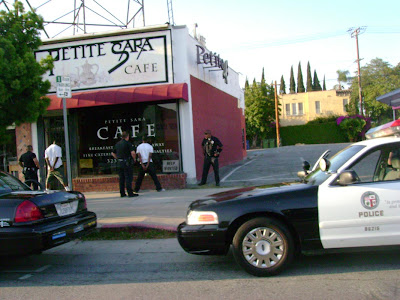
From Wiki:
Crime in Los Angeles has been a major problem in Southern California and a concern for Angelenos since the early 20th century. Crime is down 8% since 2006[1]. Los Angeles is informally known as the "Gang Capital of the Nation."
In the city of Los Angeles, crime rates are currently decreasing. However while most cities in the L.A.-area have shown a constant decrease of criminal activities over the recent years, some, such as Lancaster, Palmdale and Long Beach[2] have shown some increase in crime in 2008.
In the first half of 2008, Los Angeles reports 198 homicides - which corresponds to a rate of 9.6 (per 100,000 population) - a major decrease from 1993, when the all time homicide rate of over 21.1 (per 100,000 population) was reported for the year.[3] This included 15 officer-involved shootings. One shooting led to a SWAT member's death, Randal Simmons, the first in LAPD's history.[4]
References
1.^ http://www.lapdonline.org/home/pdf_view/34304
2.^ Crime Statistics of Long Beach, CA
3.^ Crime Rates
4.^ "Simmons, Randal". LAPD. http://www.lapdonline.org/officers_killed_in_the_line_of_duty/content_basic_view/37466. Retrieved 2008-07-09.
Tuesday, March 2, 2010
Monday, March 1, 2010
Los Angeles Morgue Files Premieres
Subscribe to:
Posts (Atom)







